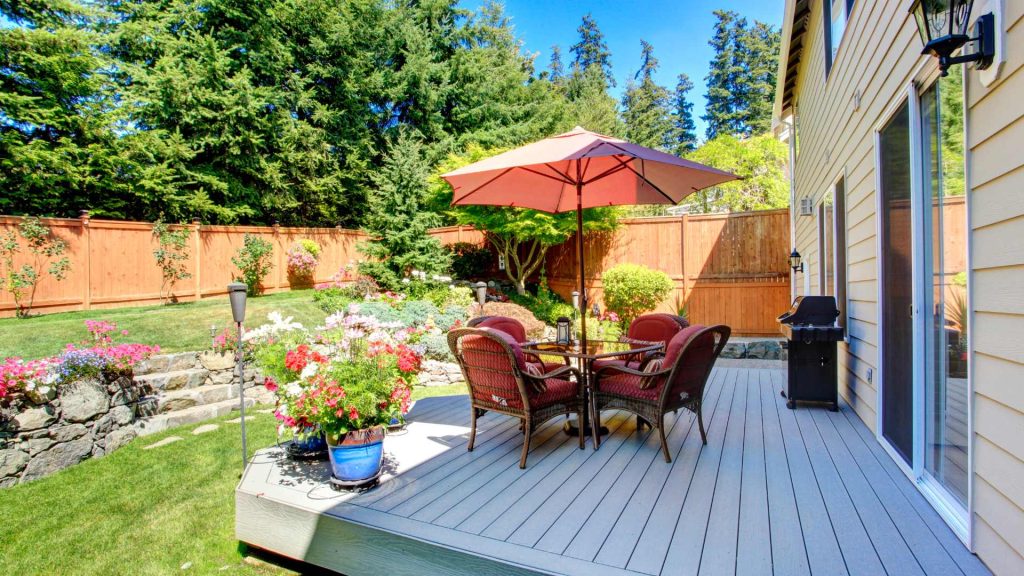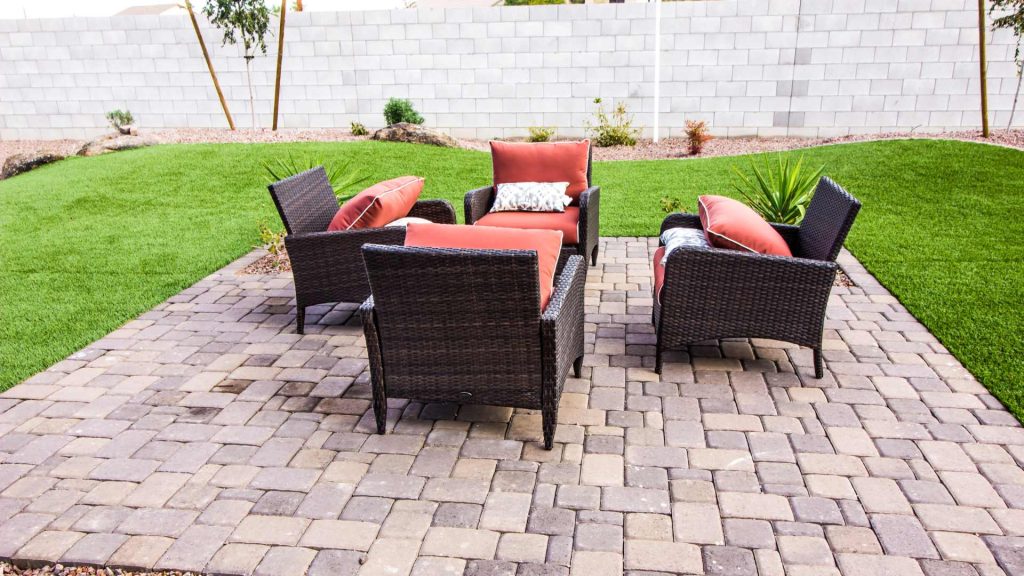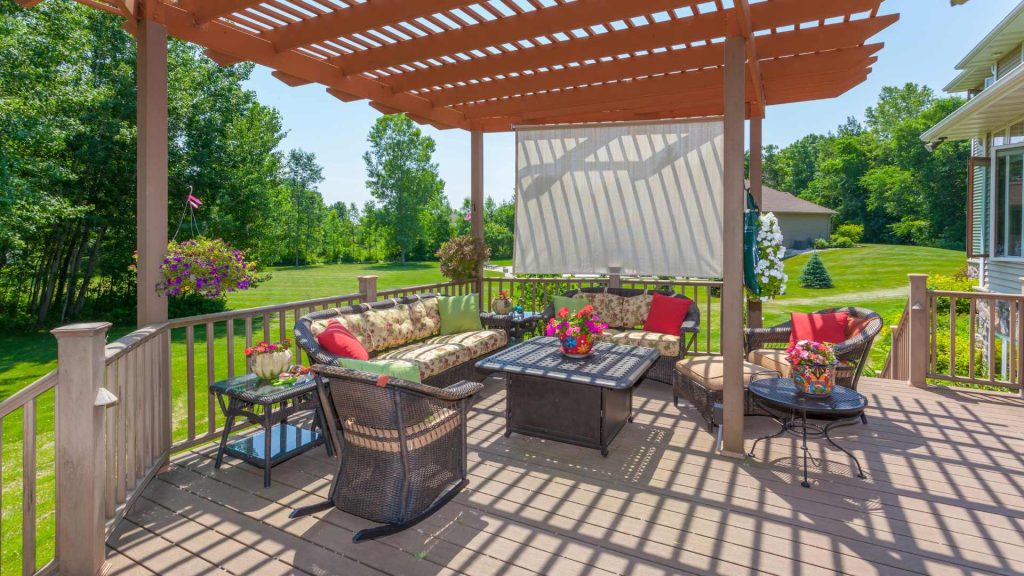Why “Hurricane‑Ready” Means More Than Just Strong Pavers
A hurricane‑ready patio or walkway isn’t merely about picking a tough material—it’s a system: properly compacted base, correct slope, stabilized joints, secure edges, and planned discharge paths so water goes where you want it. When these pieces work together, your outdoor surfaces stay level, safe, and attractive through the “wet months.”
At Pavers of Naples, we design and install patios and walkways from Pelican Bay, and Golden Gate Estates. This guide translates local experience into a practical playbook so your hardscape sheds water, resists washout, and recovers quickly after storms.
Materials That Behave Well in Storm Conditions
Travertine (tumbled/antique finishes): Feels cooler underfoot in light colors and offers good traction when wet—ideal for lanais and poolside walkways. Pair with a breathable penetrating sealer and stabilized joints.
Porcelain (outdoor‑rated textures): Near‑zero absorption, excellent salt resistance, and consistent traction ratings—great for coastal patios and modern paths. Seal joints rather than tile faces.
Concrete pavers (textured, light tones): Budget‑smart, strong for traffic, and easy to lift/reset if subsurface repairs are needed. Consider
permeable paver options or add permeable relief bands in flood‑prone zones.
The Base Is the Backbone (and Your First Drainage Layer)
Storm‑smart hardscapes start with the base. Our approach:
- Excavation & Subgrade: Remove organics and soft spots; shape the subgrade to flow water away from structures. In sandy soils, we still compact subgrade to a firm surface.
- Layered, Compacted Base: Install crushed stone in lifts and compact mechanically. Depth increases for areas with more load or poor subgrade.
- Separation Fabric: A non‑woven geotextile between native soil and base prevents fines migration, keeping the base open and draining during heavy rain.
- Bedding Layer: Screeded bedding sand (or chips for permeable systems) creates a flat plane for the pavers and allows micro‑adjustments without trapping water.

Slope & Surface Water Management (No Birdbaths!)
- Set the Slope: A subtle, even slope (typically 1–2% away from structures) moves water without feeling tilted. Steeper slopes on narrow walkways improve shed during cloudbursts.
- Break Up Large Areas: Use gentle crowns or expansions to ensure water doesn’t collect in the center of a big patio.
- Perimeter Transitions: Where patios meet lawns or beds, avoid creating dams that trap water; build a micro‑swale or permeable border so water keeps moving.
Drainage Tools That Save Patios
- Channel Drains: Set flush across door thresholds or lanai transitions to intercept and move water quickly. Connect to approved discharge points.
- Permeable Relief Bands: Insert strips of permeable pavers across a patio or along the low sides to absorb sudden runoff.
- French Drains: Subsurface trenches filled with stone and perf pipe that collect and redirect water—great along long walkways or at step‑downs.
- Catch Basins & Pop‑Ups: Collect water in depressions and redirect to safe discharge; keep grates clear before storm events.
- Gutter Tie‑Ins: Downspouts should not empty on pavers; tie into drains or add splash blocks that land on stone, not joints.

Edge Restraint: The Unsung Hurricane Hero
Wind and sheet flow push laterally on paver fields. Secure, concealed edge restraint prevents creep, especially where water accelerates around corners and turns. On curves and steps, we increase anchoring and keep joint depth full right to the edge.
Joint Stabilization
Polymeric sand is mandatory for storm‑smart hardscapes. Properly compacted and activated joints resist washout, weeds, and ants. After severe weather, top up low joints before they become channels.
Permeable vs Traditional: When to Choose Which
- Permeable Systems: Best for flat sites, heavy splash zones, or places with recurrent puddling. They use a stone reservoir to absorb and slowly release water. Ideal along walkways that follow property lines where surface runoff can’t cross a fence.
- Traditional Systems with Permeable Add‑Ons: If full permeable build is overkill, add permeable bands at the low edge, swap some solid pavers for open‑joint units, or integrate channel drains to handle peak events.
Storm‑Smart Details for Walkways
- Cross‑Slope & Crown: Give long walks a slight crown so water sheds to both sides, not just one.
- Transitions at Driveways: Add a threshold drain or permeable strip where the walk meets the driveway to prevent pooling.
- Steps & Treads: Use contrasting nosing for visibility; keep tread surfaces textured and joints flush to reduce slips during rain.
- Lighting: Low‑voltage, sealed fixtures with drainage‑friendly conduit routes. Consider a battery backup or solar hybrids for safe egress after outages.
Sealing Strategies That Don’t Backfire in a Storm
- Travertine & Concrete: Choose breathable penetrating (natural or enhanced) for storm‑exposed patios. Film‑forming sealers can be used selectively for color pop—but add non‑slip and never trap moisture under thick films.
- Porcelain: Typically seal joints only. Keep textured faces clean with neutral pH solutions so traction stays reliable in wet weather.
- Timing: Aim reseals for drier months or a reliable 48‑hour window. Moisture trapped under sealer can whiten or haze after the next storm.

Design Moves That Reduce Storm Damage (and Look Great)
- Light Tones, Matte Textures: Stay cooler, show fewer water spots, and reduce post‑storm glare.
- Border Logic: Use contrasting borders to frame edges and visually guide foot traffic during low‑light, rainy conditions.
- Planter Placement: Keep planters off the low edge of patios; if you must, set them on gravel pads so overflow doesn’t scour joints.
- Furniture & Features: Use anchorable bases for pergolas, umbrellas, and heaters, or move them to storage ahead of storms.
- Landscape Cooperation: Grade beds to pull water away from pavers; mulch can float—choose heavier aggregates near low edges.
After‑Storm Checklist for Homeowners
- Rinse & Blow Debris: Clear sand, leaves, and mulch so they don’t clog drains or stain surfaces.
- Inspect Joints & Edges: Top up polymeric sand where joints look low; re‑secure any loosened edge restraint.
- Check Drains & Outlets: Remove obstructions; flush basins and pop‑ups.
- Look for Birdbaths: Mark low spots; we can lift and re‑level small areas to restore slope.
- Assess Sealer: If water stops beading or the surface looks dull, put resealing on the calendar.
Local Case Studies
- Park Shore Lanai Patio: Tumbled travertine in a French pattern with a channel drain at the threshold and permeable bands along the garden edge. After summer storms: no standing water, clean joints, and fast dry‑out.
- Walkway: Narrow corridor walkway switched to permeable pavers over a stone reservoir with a pop‑up emitter at the front hedge—ended chronic puddling.
- Golden Gate Estates Garden Path: Long concrete paver run built with a slight crown, relief swales, and robust edge restraint; stayed straight and level after consecutive rain events.
Frequently Asked Questions
Do permeable pavers require more maintenance?
They require different maintenance. Keep joints clear of fine debris so infiltration remains high; an annual vacuum or low‑pressure rinse is usually enough.
Will my patio flood during a storm surge?
Surge is a site‑specific risk. A storm‑smart patio drains quickly after water recedes and resists scour thanks to edge restraint and stabilized joints. We can also plan breakaway sections that are inexpensive to reset if inundated.
Is a film‑forming sealer safe on outdoor steps?
Use with caution. If you want color enrichment on concrete treads, add non‑slip and choose matte finishes; test a sample board first.
Can existing patios be upgraded for storm season?
Yes: add channel drains, cut in permeable bands, re‑sand with polymeric, improve edge restraint, and re‑level low areas. These retrofits dramatically improve performance.
How soon after a storm can we use the patio?
Once surfaces are clear of debris and not slippery. If joints were disturbed, top up and re‑activate polymeric sand before heavy use.
Final Take: Design for Water, Build for Recovery
A hurricane‑ready patio or walkway isn’t about bracing for the worst—it’s about directing water, stabilizing joints, securing edges, and choosing materials that shrug off sun and splash. Do that, and your hardscape dries fast, stays level, and keeps its curb appeal year after year.

